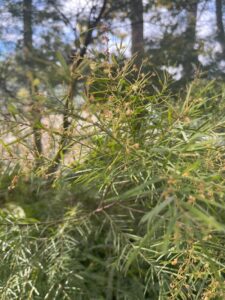How to Propagate Acacia boormanii

Propagating Acacia boormanii: A Gardener’s Guide to the Coast Wattle
Introduction:
Acacia boormanii, commonly known as the Coast Wattle, is a striking Australian native shrub prized for its weeping habit, silvery-grey foliage, and profuse displays of bright yellow flowers. Its adaptability to various soil types and its tolerance to coastal conditions make it a popular choice amongst gardeners, particularly in Australia and other regions with similar climates. However, propagating this beautiful species can present unique challenges, making successful cultivation all the more rewarding. One particularly interesting aspect is its variation in growth habit – some specimens are more upright while others exhibit a pronounced weeping form. Propagating from seed allows the possibility of preserving this diversity.
Seed Germination:
Seed germination is a viable method for propagating Acacia boormanii, but it presents some challenges. The hard seed coat inhibits water uptake, requiring pre-treatment to break dormancy. This is typically achieved through scarification, which involves lightly nicking or sanding the seed coat to allow water penetration. Stratification, while not strictly necessary, can improve germination rates. This involves soaking the seeds in water for 24-48 hours followed by a period of moist chilling (around 4°C) for 4-6 weeks. Following stratification, sow seeds in a well-draining seed-raising mix, covering them lightly with soil. Maintain consistent moisture, avoiding waterlogging. Germination can take several weeks to several months.
Challenges: Inconsistent germination rates; seed dormancy; potential for fungal diseases in seed trays if moisture levels are not carefully managed.
Rewards: High genetic diversity leading to a wide range of plant forms; potential for large-scale propagation; relatively inexpensive method.
Cuttings:
Propagating Acacia boormanii from cuttings is possible, but success rates are generally lower than with seed. Semi-hardwood cuttings taken in late spring or early summer have shown the most promise. Cuttings should be approximately 10-15cm long, with the lower leaves removed. Dip the cut ends in a rooting hormone before planting them in a well-draining propagation mix. High humidity is crucial for successful rooting, which can be achieved using a humidity dome or propagator.
Challenges: Lower success rates compared to seed; requires more specialized equipment and techniques; slower establishment than seedlings.
Rewards: Preservation of desirable traits from the parent plant; faster flowering than plants grown from seed (potentially).
Division:
Division is generally not a practical method for propagating Acacia boormanii. This species doesn’t readily form separate crowns or suckers that can be easily divided and replanted.
Tissue Culture:
Tissue culture is a viable, albeit complex and specialized method, for propagating Acacia boormanii. It offers the potential for large-scale clonal propagation of superior plants, maintaining desirable traits consistently. However, this requires specialized equipment, sterile conditions, and a detailed understanding of plant tissue culture techniques. The process involves establishing sterile cultures from plant explants and then inducing shoot multiplication and root formation.
Challenges: High initial cost of equipment and materials; requires specialized knowledge and skills; potential for contamination.
Rewards: High multiplication rate; consistent production of genetically identical plants; potential for disease-free plants.
Conclusion:
Propagating Acacia boormanii presents various challenges depending on the chosen method. While seed germination offers the greatest potential for genetic diversity, it requires patience and careful management. Cuttings offer a faster way to propagate selected individuals but have lower success rates. Division is impractical, while tissue culture provides large-scale propagation but demands significant expertise and resources.
Despite the difficulties, successfully cultivating this beautiful wattle from any of these methods yields a unique satisfaction. The perseverance required, coupled with the eventual reward of a thriving Coast Wattle, provides a tangible sense of accomplishment and a deep appreciation for the resilience and beauty of this Australian native. Aspiring propagators are encouraged to start with seed germination, learning from each experience to refine their techniques and ultimately enjoy the fruits – or rather, the flowers – of their labor.